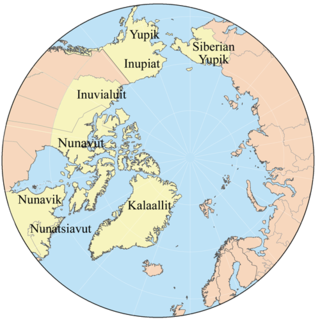
Eskimo is a term used to refer to two closely related Indigenous peoples: The Inuit and the Yupik of eastern Siberia and Alaska. A related third group, the Aleut, which inhabit the Aleutian Islands, are generally excluded from the definition of Eskimo. The three groups share a relatively recent common ancestor, and speak related languages belonging to the Eskimo–Aleut language family.

The Inuit languages are a closely related group of indigenous American languages traditionally spoken across the North American Arctic and adjacent subarctic, reaching farthest south in Labrador. The related Yupik languages are the two main branches of Eskaleut, a primary language family. The Inuit live primarily in three countries: Greenland, Canada, and the United States.

The Yupik are a group of indigenous or aboriginal peoples of western, southwestern, and southcentral Alaska and the Russian Far East. They are related to the Inuit and Iñupiat. Yupik peoples include the following:

The Iñupiat are a group of Alaska Natives, whose traditional territory roughly spans northeast from Norton Sound on the Bering Sea to the northernmost part of the Canada–United States border and often claim to be the first people of the Kauwerak. Their current communities include 34 villages across Iñupiat Nunaŋat including seven Alaskan villages in the North Slope Borough, affiliated with the Arctic Slope Regional Corporation; eleven villages in Northwest Arctic Borough; and sixteen villages affiliated with the Bering Straits Regional Corporation.

The Eskimo–Aleut, Inuit–Yupik–Unangan, or Eskaleut languages are a language family native to Alaska, Nunavut, northern Northwest Territories, northern Quebec (Nunavik), northern Labrador (Nunatsiavut), Greenland and far eastern Russia. It is also known as Eskaleutian, Eskaleutic or Inuit–Yupik–Unangan.
Traditional Inuit music, the music of the Inuit, Yupik, and Iñupiat, has been based on drums used in dance music as far back as can be known, and a vocal style called katajjaq has become of interest in Canada and abroad.

Siberian Yupiks, or Yuits, are a Yupik people who reside along the coast of the Chukchi Peninsula in the far northeast of the Russian Federation and on St. Lawrence Island in Alaska. They speak Central Siberian Yupik, a Yupik language of the Eskimo–Aleut family of languages.

The Inuit Circumpolar Council (ICC), formerly Inuit Circumpolar Conference, is a multinational non-governmental organization (NGO) and Indigenous Peoples' Organization (IPO) representing the 180,000 Inuit, Yupik, and Chukchi peoples people living in Alaska, Canada, Greenland, and Chukotka (Russia). ICC was ECOSOC-accredited and was granted special consultative status at the UN in 1983.
Eskimo kinship or Inuit kinship is a category of kinship used to define family organization in anthropology. Identified by Lewis Henry Morgan in his 1871 work Systems of Consanguinity and Affinity of the Human Family, the Eskimo system was one of six major kinship systems. The system of English-language kinship terms falls into the Eskimo type.
Central Siberian Yupik, is an endangered Yupik language spoken by the indigenous Siberian Yupik people along the coast of Chukotka Autonomous Okrug in the Russian Far East and in the villages of Savoonga and Gambell on St. Lawrence Island.

The Yupik languages are the distinct languages of the several Yupik peoples of western and south-central Alaska and northeastern Siberia. The Yupik languages differ enough from one another that they are not mutually intelligible, although speakers of one of the languages may understand the general idea of a conversation of speakers of another of the languages. One of them, Sirenik, has been extinct since 1997.

Iñupiaq, Inupiaq, Iñupiat, Inupiat, Iñupiatun or Alaskan Inuit is an Inuit language, or perhaps languages, spoken by the Iñupiat people in northern and northwestern American Alaska, as well as a small adjacent part of the Canadian Northwest Territories. The Iñupiat language is a member of the Inuit-Yupik-Unangax language family, and is closely related to other Inuit languages of Canada and Greenland. There are roughly 2,000 speakers. It is considered a threatened language with most speakers at or above the age of 40. Iñupiaq is an official language of the State of Alaska.

An ulu is an all-purpose knife traditionally used by Inuit, Iñupiat, Yupik, and Aleut women. It is utilized in applications as diverse as skinning and cleaning animals, cutting a child's hair, cutting food and, if necessary, trimming blocks of snow and ice used to build an igloo.

Masks among Eskimo peoples served a variety of functions. Masks were made out of driftwood, animal skins, bones and feathers. They were often painted using bright colors. There are archeological miniature maskettes made of walrus ivory, dating from early Paleo-Eskimo and from early Dorset culture period.

Traditional Alaskan Native religion involves mediation between people and spirits, souls, and other immortal beings. Such beliefs and practices were once widespread among Inuit, Yupik, Aleut, and Northwest Coastal Indian cultures, but today are less common. They were already in decline among many groups when the first major ethnological research was done. For example, at the end of the 19th century, Sagdloq, the last medicine man among what were then called in English, "Polar Eskimos", died; he was believed to be able to travel to the sky and under the sea, and was also known for using ventriloquism and sleight-of-hand.

The World Eskimo-Indian Olympics is an annual multi-sport event held over a four-day period beginning the 3rd Wednesday each July, designed to preserve cultural practices and traditional (survival) skills essential to life in circumpolar areas of the world. The WEIO features games or sports rooted in ancestral hunting and survival techniques employed by the Inuit, Iñupiat, Yupik, and other Native Americans, as well as dance storytelling competitions, and an annual cultural pageant, called Miss WEIO, that focuses on cultural knowledge.

Circumpolar peoples and Arctic peoples are umbrella terms for the various Indigenous peoples of the Arctic.

The Inuit 'the people', singular: Inuk, ᐃᓄᒃ, dual: Inuuk, ᐃᓅᒃ ) are a group of culturally similar indigenous peoples inhabiting the Arctic and subarctic regions of Greenland, Canada, and Alaska. The Inuit languages are part of the Eskimo–Aleut languages also known as Inuit-Yupik-Unangan and also as Eskaleut. Inuit Sign Language is a critically endangered language isolate used in Nunavut.

Qargi, Qasgi or Qasgiq, Qaygiq, Kashim, Kariyit, a traditional large semi-subterranean men's community house' of the Yup'ik and Inuit, also Deg Hit'an Athabaskans, was used for public and ceremonial occasions and as a men’s residence. The Qargi was the place where men built their boats, repaired their equipment, took sweat baths, educated young boys, and hosted community dances. Here people learned their oral history, songs and chants. Young boys and men learned to make tools and weapons while they listened to the traditions of their forefathers.

An Eskimo yo-yo or Alaska yo-yo is a traditional two-balled skill toy played and performed by the Eskimo-speaking Alaska Natives, such as Inupiat, Siberian Yupik, and Yup'ik. It resembles fur-covered bolas and yo-yo. It is regarded as one of the most simple, yet most complex, cultural artifacts/toys in the world. The Eskimo yo-yo involves simultaneously swinging two sealskin balls suspended on caribou sinew strings in opposite directions with one hand. It is popular with Alaskans and tourists alike. This traditional toy is two unequal lengths of twine, joined together, with hand-made leather objects at the ends of the twine.
















